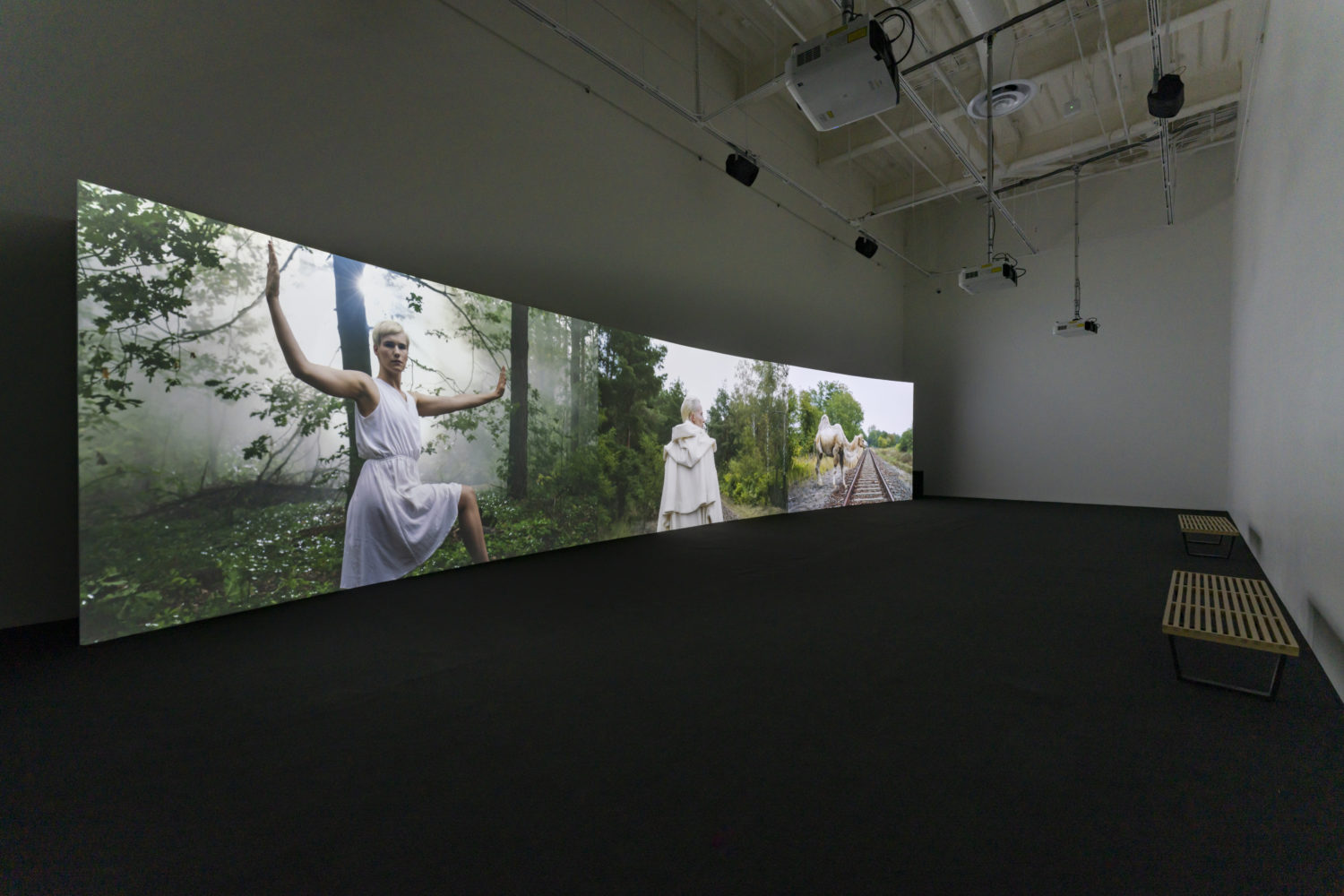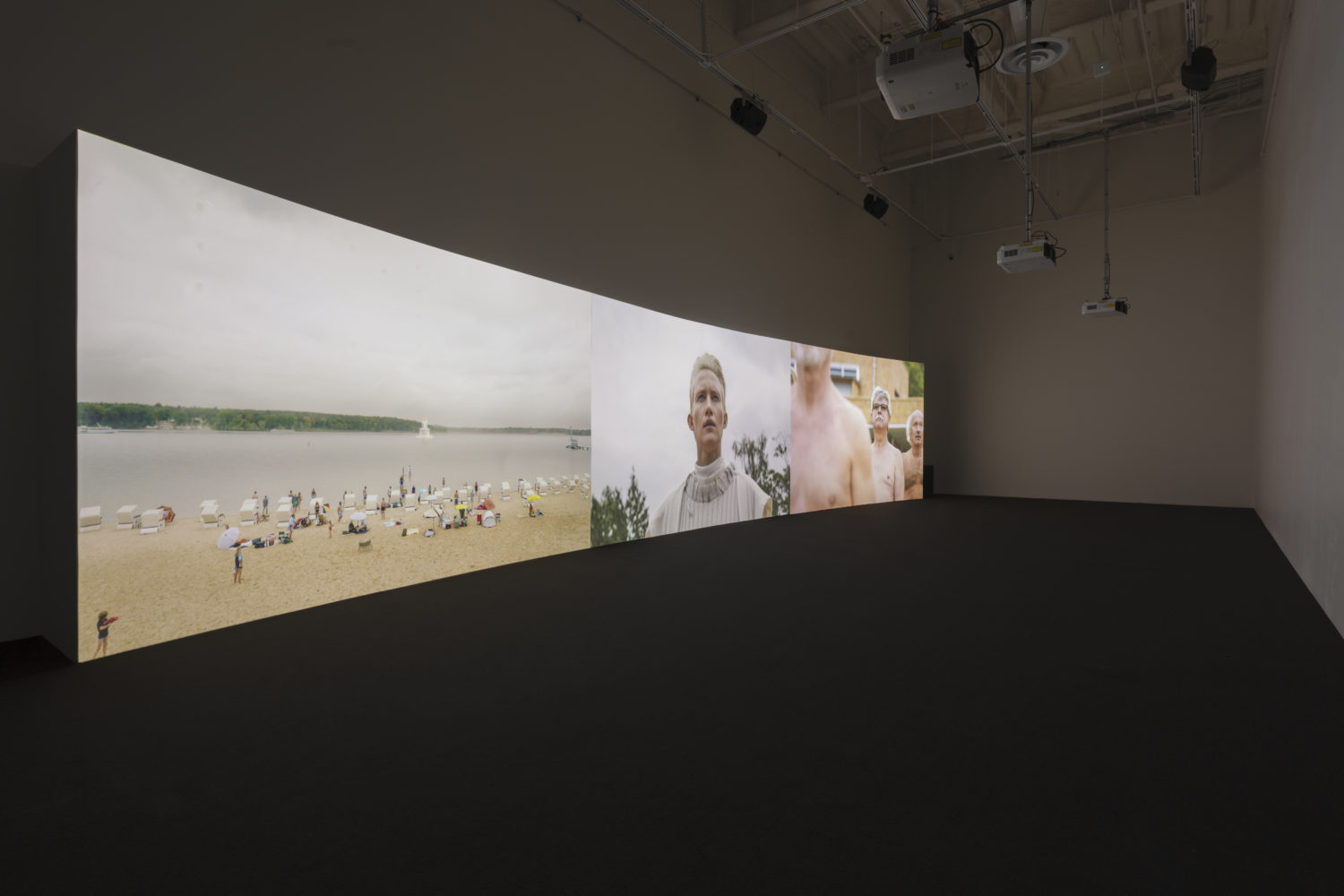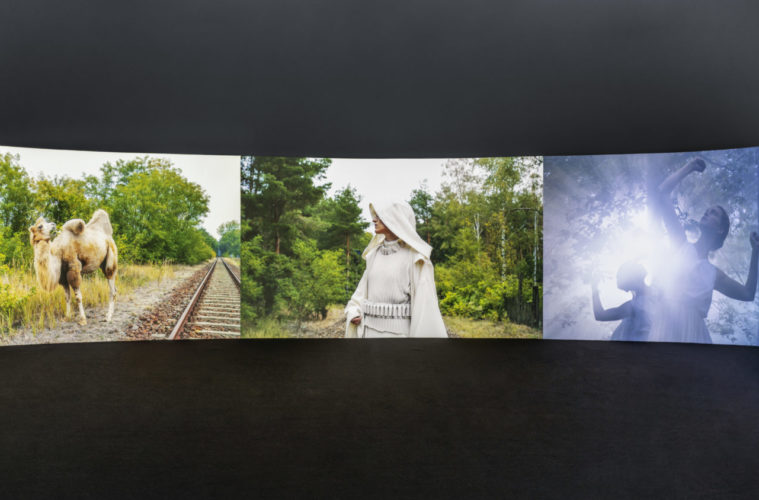The immersive film “Malka Germania” (“Queen Germania” in Hebrew) references our personal and collective trauma about war and subjugation and artfully turns that trauma into manna. The 40-minute three-channel video is created by Israeli native Yael Bartana who moved to Berlin to escape her native country’s political climate and to live near a major European art scene.
The deeply reflective Bartana has spent a lifetime engrossing herself in the history and persecution of the Jewish people. With this background, she uses her talent and expertise in filmmaking, performance art and acting to explore and reveal in “Malka Germania” the world’s deep regrets about the Holocaust. She further investigates the German peoples’ longing for collective redemption of the devastating behavior of their recent and centuries gone ancestors.
On another level, the character Malka in the film morphs into a kind of Messiah. As an elegant androgynous figure, she wears a long, hooded cream-colored robe and moves very slowly and intensely throughout contemporary Berlin. With no dialogue and with new age music, enhanced by sounds from the forest, echoes of people talking, helicopters flying overhead and soldiers marching, Malka roams or rides a donkey through a German forest and along railroad tracks (evoking the time when Jews were taken to concentration camps and murdered).

Film still, Malka Germania, 2022, © Yael Bartana, courtesy of the artist.
@uag_ucirvine
Malka also roams near historic and political landmarks, including the Brandenburg Gate, the Berlin Victory Column, Wannsee, and the Tempelhof Airfield, sometimes accompanied by a gentle camel, whose demeanor and movements echo hers.
Many other characters inhabit this mesmerizing film, which is a fever dream according to Juli Carson, UCI Professor of Art, curator and gallery director. Carson, who has lived in war-torn countries, adds that with Russia’s recent invasion of Ukraine, “Malka Germania” is relevant and important today.
The film further compels the viewer to look within oneself to the history of fellow humans being persecuted and even becoming predators. It then becomes a Jungian journey for those willing to examine their personal and family histories as metaphors for and reflections of the larger world’s legacy of war and domination. Or as the saying goes, “The personal is political.”
As the catalog for the film explains, “Malka realizes that she has a certain power, and she will use it for Malka was and will remain someone who more than anyone is aware of the injustices of the city, of its history and its people… and because of the passion burning within her, she knows that from now on things will change as a result of her arrival.”
The catalog continues, “In a psychotherapeutic approach, Bartana brings the city’s traumata out of their shadows of the collective subconscious quite literally into the light of the video screen… we as curators together with Yael Bartana propose to engage with art utilizing the dialectic and polyphonic methodology of Talmudic tradition, to ask questions instead of waiting for answers, and to follow in art’s lead of creating nuance, ambiguities, alternatives and complexities.”

Photo by Yubo Dong / ofstudio photography (@ofphotostudio)
“Malka Germania,” which was previously shown as part of Bartana’s 2020 exhibition “Redemption Now” at the Jewish Museum Berlin, is not a violent art piece. With its gentle allegorical aspects and with scenes slowly segueing from one to the other, the film can affect viewers in a more subliminal way, urging us to recall images of persecution depicted in the media over decades, in history courses and perhaps from our own lives.
Watching the film can further plunge viewers into the darker aspects of our collective unconscious if we’re willing to go there. As Jewish Museum Berlin curators Shelley Harten and Gregor H. Lersch remarked, the film flushes Berlin’s “fears, dreams, repressed traumata and memories onto the surface.”
Characters in the film’s scenes include soldiers of the Israeli Defense Forces marching, beautiful female dancers from eras gone by with arms reaching for the sky, athletic young men wearing shorts and T-shirts, running through the city and countryside, evoking Hitler Youth, as well as an old-fashioned European organ grinder and a man blowing into a shofar (a ram’s horn trumpet used in Jewish religious services).
There are several scenes of Nordic-looking blonde-haired sunbathers, men and women of all ages and beautiful children relaxing, playing, conversing, building sandcastles and riding in small pleasure boats along the lakes in the Wannsee area of Berlin. As the sunbathers relax, helicopters fly overhead.

Photo by Yubo Dong / ofstudio photography (@ofphotostudio)
Wannsee is further significant as it was the site of the Wannsee Conference of senior Nazi officials, held in 1942, to implement the Final Solution or the deportation to Concentration Camps and ultimate murder of millions of Jews.
Interspersed throughout the film, young yarmulke (Jewish skull caps) clad men, Orthodox Jews, walk through Berlin carrying street signs with Hebrew letters. They stop at German street signs, replacing them with the Hebrew ones. The underlying intention is to rewrite the history of Germany; to provoke “the transfer of the city from the stewardship of Berliner to the Jewish Diaspora,” as curator Carson wrote; and to consider what Berlin would be like today if Israeli soldiers, rather than the Red Army units, liberated the city from the Nazis.
The film’s final scenes include several relics of Nordic Germania – beer steins, plates and sculptural busts – being tossed from apartment windows and shattering on the city streets, as elderly couples survey the devastation from their own windows. These images symbolize the collective German desire to eradicate their barbaric history.
Another concluding scene is of a computer-animated, mirage-like image depicting a Nazi giant “Hall of the People” rising from a Wannsee lake. This structure is based on Nazi architect Albert Speer’s design to be constructed following Germany’s victory in World War II. The model appears like the lost city of Atlantis, created by Plato around 360 B.C. as a fable about the consequences of corruption and arrogance.

Photo by Yubo Dong / ofstudio photography (@ofphotostudio)
The film’s final scene reveals hordes of Berliners, now turned into emigrants, carrying suitcases, walking along the railroad tracks, leaving the city for good, as Malka looks on approvingly. The suggested message is that Malka the Messiah has cleansed Berlin of its horrifying history.
“Malka Germania” is pure fantasy. Yet its execution and cinematography, along with its carefully chosen and edited scenes, including those of “Aryan” young men, transitioning into scenes with Israeli Defense Forces and Orthodox Jews, can reach into our collective unconscious while invoking the depravity of war and conquest. The film is not for the faint of heart or spirit; yet its message is vitally important for the times we live in.
Malka Germania is on view at UCI’s Contemporary Arts Center through April 9; Tue.-Sat., noon-6 p.m.; [email protected], uag.arts.uci.edu.
Advertising disclosure: We may receive compensation for some of the links in our stories. Thank you for supporting Irvine Weekly and our advertisers.

